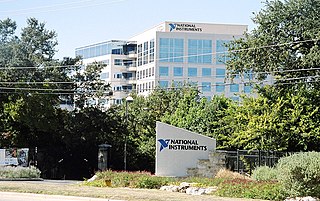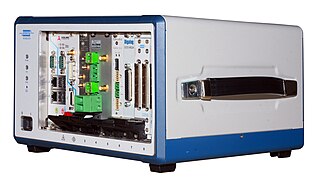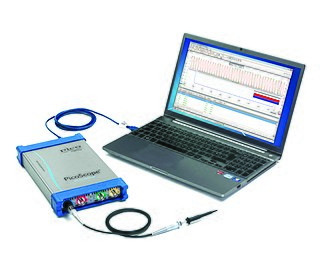
Delphi is a software product that uses the Delphi dialect of the Object Pascal programming language and provides an integrated development environment (IDE) for rapid application development of desktop, mobile, web, and console software, currently developed and maintained by Embarcadero Technologies.
LAN eXtensions for Instrumentation (LXI) is a standard developed by the LXI Consortium, a consortium that maintains the LXI specification and promotes the LXI Standard. The LXI standard defines the communication protocols for instrumentation and data acquisition systems using Ethernet. Ethernet is a ubiquitous communication standard providing a versatile interface, the LXI standard describes how to use the Ethernet standards for test and measurement applications in a way that promotes simple interoperability between instruments. The LXI Consortium ensures LXI compliant instrumentation developed by various vendors work together with no communication or setup issues. The LXI Consortium ensures that the LXI standard complements other test and measurement control systems, such as GPIB and PXI systems.

Laboratory Virtual Instrument Engineering Workbench (LabVIEW) is a system-design platform and development environment for a visual programming language from National Instruments.

NI, formerly National Instruments Corporation, is an American multinational company with international operation. Headquartered in Austin, Texas, it is a producer of automated test equipment and virtual instrumentation software. Common applications include data acquisition, instrument control and machine vision.

Automatic test equipment or automated test equipment (ATE) is any apparatus that performs tests on a device, known as the device under test (DUT), equipment under test (EUT) or unit under test (UUT), using automation to quickly perform measurements and evaluate the test results. An ATE can be a simple computer-controlled digital multimeter, or a complicated system containing dozens of complex test instruments capable of automatically testing and diagnosing faults in sophisticated electronic packaged parts or on wafer testing, including system on chips and integrated circuits.
Keysight VEE is a graphical dataflow programming software development environment from Keysight Technologies for automated test, measurement, data analysis and reporting. VEE originally stood for Visual Engineering Environment and developed by HP designated as HP VEE; it has since been officially renamed to Keysight VEE. Keysight VEE has been widely used in various industries, serving the entire stage of a product lifecycle, from design, validation to manufacturing. It is optimized in instrument control and automation with test and measurement devices such as data acquisition instruments like digital voltmeters and oscilloscopes, and source devices like signal generators and programmable power supplies.

PCI eXtensions for Instrumentation (PXI) is one of several modular electronic instrumentation platforms in current use. These platforms are used as a basis for building electronic test equipment, automation systems, and modular laboratory instruments. PXI is based on industry-standard computer buses and permits flexibility in building equipment. Often modules are fitted with custom software to manage the system.
LabWindows/CVI is an ANSI C programming environment for test and measurement developed by National Instruments. The program was originally released as LabWindows for DOS in 1987, but was soon revisioned for the Microsoft Windows platform. The current version of LabWindows/CVI is 2019.
The Microsoft Enterprise Library is a set of tools and programming libraries for the Microsoft .NET Framework. It provides APIs to facilitate proven practices in core areas of programming including data access, logging, exception handling and others. Enterprise Library is provided as pluggable binaries and source code, which can be freely used and customized by developers for their own purposes. It also ships with test cases and quickstarts.
Instrument control consists of connecting a desktop instrument to a computer and taking measurements.

Visual Basic is a third-generation event-driven programming language from Microsoft known for its Component Object Model (COM) programming model first released in 1991 and declared legacy during 2008. Microsoft intended Visual Basic to be relatively easy to learn and use. Visual Basic was derived from BASIC and enables the rapid application development (RAD) of graphical user interface (GUI) applications, access to databases using Data Access Objects, Remote Data Objects, or ActiveX Data Objects, and creation of ActiveX controls and objects.

Origin is a proprietary computer program for interactive scientific graphing and data analysis. It is produced by OriginLab Corporation, and runs on Microsoft Windows. It has inspired several platform-independent open-source clones and alternatives like LabPlot and SciDAVis.
The following tables provide a comparison of numerical-analysis software.
Azure DevOps Server is a Microsoft product that provides version control, reporting, requirements management, project management, automated builds, testing and release management capabilities. It covers the entire application lifecycle, and enables DevOps capabilities. Azure DevOps can be used as a back-end to numerous integrated development environments (IDEs) but is tailored for Microsoft Visual Studio and Eclipse on all platforms.

Microsoft Visual Studio is an integrated development environment (IDE) from Microsoft. It is used to develop computer programs, as well as websites, web apps, web services and mobile apps. Visual Studio uses Microsoft software development platforms such as Windows API, Windows Forms, Windows Presentation Foundation, Windows Store and Microsoft Silverlight. It can produce both native code and managed code.
VI Technology was a privately owned company based in Austin, Texas that provided enterprise test solutions and services. These solutions ranged from benchtop test systems to enterprise-wide test solutions. VI Technology's main product, Arendar, was used by engineering teams in design, characterization, validation, and manufacturing. Working together with key partners, Microsoft and National Instruments, VI Technology had worked with companies from the semiconductor, communications, high-tech electronics, defense, biomedical, and automotive industries. VI Technology original corporate headquarters was located in Austin, TX, with branch locations in Dallas, TX and Mountain View, CA.
An instrument driver, in the context of test and measurement (T&M) application development, is a set of software routines that simplifies remote instrument control. Instrument drivers are specified by the IVI Foundation and define an I/O abstraction layer using the virtual instrument software architecture (VISA). The VISA hardware abstraction layer provides an interface-independent communication channel to T&M instruments. Furthermore, the instrument drivers encapsulate the Standard Commands for Programmable Instruments (SCPI) commands, which are an ASCII-based set of commands for reading and writing instrument settings and measurement data. This standard allows an abstract way of using various programming languages to program remote-control applications instead of using SCPI commands. An instrument driver usually has a well-defined API.
Java code coverage tools are of two types: first, tools that add statements to the Java source code and require its recompilation. Second, tools that instrument the bytecode, either before or during execution. The goal is to find out which parts of the code are tested by registering the lines of code executed when running a test.

CompactDAQ is a data acquisition platform built by National Instruments that includes a broad set of compatible hardware and software. CompactDAQ integrates hardware for data I/O with LabVIEW software to enable engineers to collect, process and analyse sensor data. CompactDAQ systems are less expensive than equivalent systems within the NI PXI Platform.

Pico Technology is a British manufacturer of high-precision PC-based oscilloscopes and automotive diagnostics equipment, founded in 1991. Their product range includes the PicoScope line of PC-based oscilloscopes, data loggers, automotive equipment, and most recently, handheld USB-based oscilloscopes. Since their inception in 1991, Pico Tech has been researching and developing PC-based oscilloscopes, when the market standard was analogue storage oscilloscopes. Pico Technology is one of two European scope manufacturers, and competes in the low to middle end of the instrumentation market.








